EU International Relations (Online Course)
Course “International Economic Relations of the European Union” (e-learning,
8 ECTS,  )
)
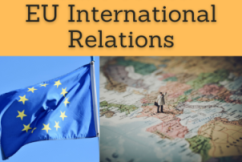
Two modules compose the Professional Course “EU International Economic Relations” taught by EENI Global Business School:
1- Foreign Policy of the EU
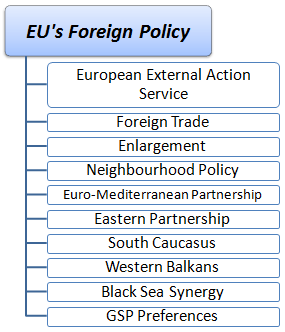
2- EU Association and Trade Agreements with the third countries


 Enrol / Request for Information
Enrol / Request for Information

- Credits: 8

- Duration: 2 months It is recommended to dedicate about twelve hours of study per week following a flexible schedule. It is possible to reduce the duration dedicating more hours a week
- Tuition Fees: EUR 192
- Open Online Enrollment
- Download the syllabus of the Course (PDF)
Languages:  .
.
- Also available in For improving the international communication skills, the student has free access to the learning materials in these languages (free multilingual training).
 Curso Relaciones UE
Curso Relaciones UE  Cours relations internationales de l’UE
Cours relations internationales de l’UE  Relações Internacionais da UE
Relações Internacionais da UE
The main objective of the Course “International Economic Relations of the EU” (8 ECTS) is to understand the complex Foreign Policy of the EU and to know the fifty trade agreements with the third countries.
The goals of the EU Foreign Policy are to increase its influence globally, promote peace, democracy or human rights, as well as boost the European foreign trade.
With the aim of reducing the trade barriers and facilitating the market access for the European exports to the third countries, the EU has trade agreements and association agreements with several countries and regions. These trade agreements offer significant advantages and business opportunities for the exporters and importers.
Knowing the characteristics and functioning of these agreements is vital for any exporting or importing company.
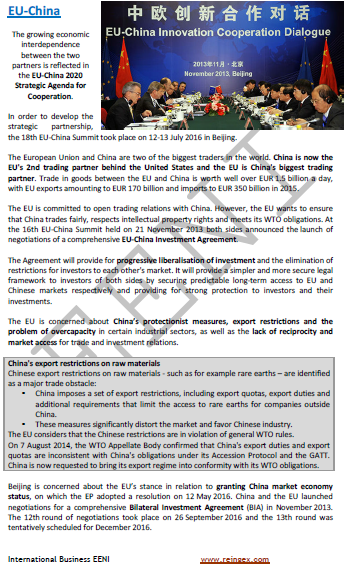
Course intended for all those wishing to understand the EU complex Foreign Policy and the EU trade agreements.

This course contains exercises that are evaluated, which the student must work out and pass to obtain the Diploma of the Professional Course: “International Economic Relations of the EU” issued by EENI Global Business School.
Students who have taken this course can validate and register for a Master or Doctorate at EENI.
This course belongs to the following Higher Education Programs taught by EENI:
Doctorate: European Business, World Trade.
Masters for the Students from the
 EU.
EU.
Subjects and aims
- EU Foreign Policy: External Relations and Trade Policy of the EU
- European External Action Service: the EU diplomatic corps
- Foreign Trade of the EU: 19% of the world trade
- Generalized System of Preferences (GSP) of the EU: tariff preferences for the Developing Countries
- EU Enlargement: the European Countries that are candidates to enter the EU
- European Neighborhood Policy: relations with the neighboring countries of Eastern Europe and Southern Mediterranean
- Euro-Mediterranean Partnership: towards an Euro-Mediterranean Free-Trade Area
- Eastern Partnership of the EU: Free-Trade Areas with South Caucasus and Eastern Europe
- South Caucasus: association agreements
- Western Balkans: EU-Balkans Free-Trade Area
- Black Sea Synergy
- Adriatic-Ionian Initiative
- EU-CELAC Summit
- Asia-European Union (ASEM)
- Central European Initiative
- OSCE
- Council of the Baltic Sea States
- Regional Cooperation Council
- Indian Ocean Commission (observer)
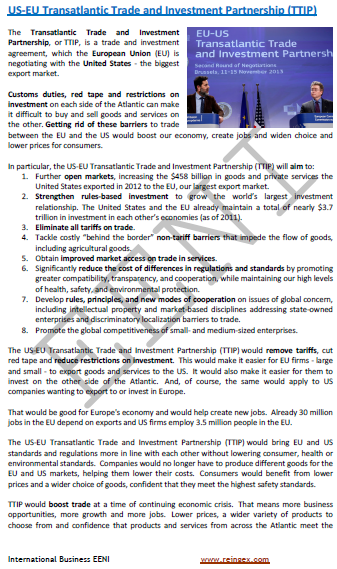
The specific aims of the module one “Foreign Policy of the European Union” are:
- To know the pillars of the European Foreign Policy and its strategies by regions
- To understand the role of the European External Action Service (EEAS) as the EU diplomatic corps and know its programs
- To analyze the external trade and the investment flows (FDI) of the EU
- To understand the Trade Regimes of the EU applicable to the developing countries
- To learn about the new Generalized System of Preferences (GSP), GSP+ and the EU Everything but Arms provision
- To know which countries and under what conditions they are beneficiaries of the GSP and how to use the rules of origin
- To know the EU enlargement process for Macedonia, Albania, Bosnia and Herzegovina, Montenegro, Serbia, Kosovo and Turkey
- To understand the strategic importance of the European Neighborhood Policy with the neighboring countries of the Mediterranean and Eastern Europe
- To know the pillars of the Euro-Mediterranean Partnership (EUROMED) and the EU partnership agreements with the Southern Mediterranean countries: Algeria, Egypt, Israel, Jordan, Lebanon, Libya, Morocco, Palestine, Syria, Tunisia, and Turkey
- To know the pillars of the Eastern Partnership with Armenia, Azerbaijan, Belarus, Georgia, Moldova and Ukraine, as well as the Association Agreements and the Free-Trade Areas of the EU with these markets
- To analyze the EU partnership agreements with the South Caucasus: Armenia, Azerbaijan and Georgia
- To know the partnership agreements with the Western Balkans: Albania, Bosnia and Herzegovina, Macedonia, Montenegro, Serbia and Kosovo
- To know the initiative of the Black Sea Synergy of the EU
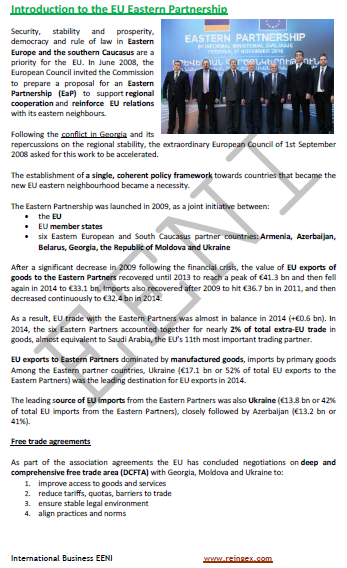
Module two- EU Association and Trade Agreements with the third countries.
1- Free trade agreements (FTA) of the EU.
2- EU relations with the strategic partners:
- U.S.
- The future Transatlantic Trade and Investment Partnership (TTIP)
- Canada (CETA Trade Agreement)
- China
- India
- South Korea (Free Trade Agreement, 2015)
- EU-United Kingdom Free Trade and Economic Integration Agreement
3- EU Agreements with the American Countries:
- Andean Countries (2012)
- EU-Peru-Colombia Agreement
- MERCOSUR
- Mexico (Economic Partnership Agreement, Political Coordination and Cooperation, 2000)
- Economic Association Agreements with Central America (2012), Chile (2005)
- Trade Agreement provisionally applied with Ecuador (2017)
- EU-CARIFORUM Economic Partnership Agreement
4- EU Agreements with other European Countries:
- EFTA (European Economic Area)
- EU-Russia Partnership and Cooperation Agreement
- Stabilization and Association Agreements with Albania (2006), Bosnia and Herzegovina (2015), Kosovo (2016), Macedonia (2004)
- EU-Montenegro Stabilization and Accession Agreement (2010)
- EU-Serbia Stabilization and Association Agreement
- EU-Bosnia and Herzegovina Stabilization and Accession Agreement (2015)
- Association Agreement with Moldova (2016)
- EU-Georgia Free Trade and Agreement
- The EU has a Deep and Comprehensive Free Trade Agreement (2016) and Association Agreement (2014) with Ukraine
- Trade Agreement with the Faroe Islands (1997)
- Collaboration and Cooperation Agreements with Armenia (1999) and Azerbaijan (1999)
- Customs Union with Andorra (1991), San Marino (1992) and Turkey
5- EU Agreements with the Asian Countries:
- ASEAN (Association Agreement)
- EU-Singapore Agreement
- EU-Vietnam Agreement
- EU-Japan Agreement
- Partnership and Cooperation Agreement with Kazakhstan (2016)
- Provisional Association Agreements with Papua New Guinea (2011) and Fiji
6- EU Agreements with the Arab Countries:
- Gulf Cooperation Council (GCC)
- Association Agreements with Israel (2000), Jordan (2002), Lebanon (2003), the Palestinian Authority (1997) and Syria (1977)
- Partnership and Cooperation Agreement with Iraq (2012)
7- EU Agreements with the African Countries:
- EU-Africa Strategic Partnership (Cotonou Agreement)
- Agadir Agreement
- Economic Partnership Agreements with Algeria (2005), Ivory Coast (2016), Egypt (2004), Morocco (2000), Tunisia (1998), Cameroon, Ghana (pendent)
- Economic Partnership Agreement in negotiation with the West African Countries (ECOWAS, UEMOA)
- Trade, Development and Cooperation Agreement with South Africa (2000)
- Economic Partnership Agreements Interim with Cameroon (2009) and with the East African Community (EAC) (negotiation)
- Economic Partnership Agreements provisionally applied with Ghana (2016)
- EU-Southern African Development Community (SADC) Free Trade Agreement (FTA)
- Economic Partnership Agreement with Madagascar, Mauricio, the Seychelles and Zimbabwe (2009)
- Free Trade Agreement EU-Eastern and Southern African States (Madagascar, Mauritius, Seychelles, Zimbabwe)
8- Tools for exporters and importers:
- Market Access Database (MADB) for the European exports to the third countries
- The EU Export Helpdesk: EU export/import tariffs with the developing countries
The specific aims of the module two “FTAs of the EU with the third countries” of the Professional Course are:
- To know the pillars and objectives of the EU trade agreements
- To analyze the different types of agreements of the EU: economic partnership agreements, Trade Agreements, Free-Trade Areas, customs unions and the so-called autonomous trade regimes
- To know how to apply the rules of origin of the different trade agreements
- To analyze the EU Agreements with the strategic partners: United States, Canada, China, India and South Korea
- To analyze the EU trade agreements with America, Africa, Europe, Asia and the Arab countries
- The explore the Market Access Database and the Export Helpdesk tool of the EU
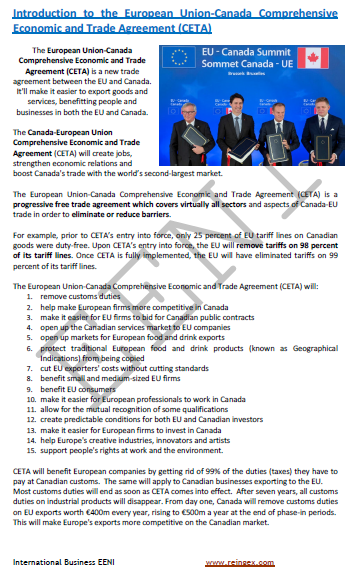
The course includes the Market Access Tool:
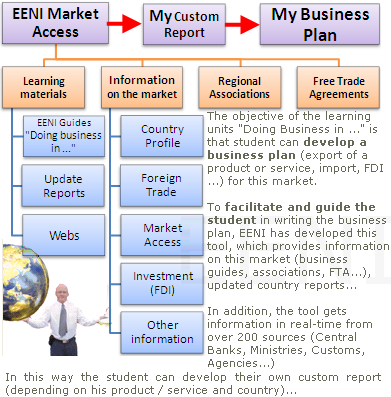
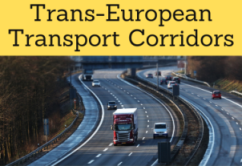
- Atlantic Corridor
- Baltic-Adriatic Corridor
- North Sea-Baltic Corridor
- North Sea-Mediterranean Corridor
- Mediterranean Transport Corridor
- Eastern Europe-Eastern Mediterranean Transport Corridor
- Scandinavian-Mediterranean Transport Corridor
- Rhine-Alpine Transport Corridor
- Rhine-Danube Transport Corridor
- Strasbourg-Danube Transport Corridor
- Pan-European Corridor II
- Pan-European Corridor IX
(c) EENI Global Business School (1995-2024)
We do not use cookies
Top of this page



